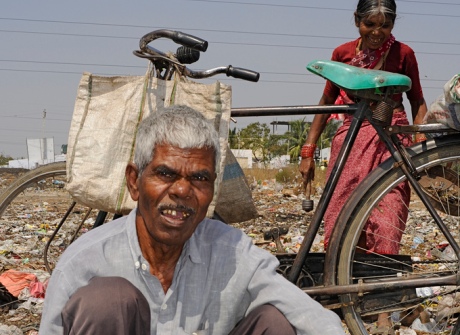Red Pepper
29 September 2011
 The concept of microcredit - tiny microloans used to help establish or expand income-generating microenterprises – was for a long time seen by the neoliberal policy-making establishment as the perfect self-help answer to poverty, unemployment and underdevelopment.
The concept of microcredit - tiny microloans used to help establish or expand income-generating microenterprises – was for a long time seen by the neoliberal policy-making establishment as the perfect self-help answer to poverty, unemployment and underdevelopment.Long associated with the passion and practical work of Bangladeshi economist and Nobel Peace Prize recipient, Dr Muhammad Yunus, and a little later with Peruvian economist, Hernando De Soto, great things were promised. Muhammad Yunus famously said that ‘poverty would be eradicated in a generation’, and the very notion of poverty itself would soon be ‘consigned to a museum’ to which children would have to go on study tours to see what all the fuss was about.
In Latin America, Hernando De Soto predicted that the continent’s economic and social salvation lay with a massive expansion of the informal sector, and the supposedly productive activities of millions of what he termed its ‘heroic entrepreneurs’. With such seductive forms of ‘capitalism for the poor’ on offer, the key international development institutions, and the US government in particular, fell over themselves to finance the idea of microcredit. The microcredit movement was born.
Unfortunately, after nearly thirty years of experience in the field, it is now quite clear that both Yunus and De Soto have turned out to be spectacularly wrong. A growing number of analysts have documented that this is indeed the case in Latin America, Asia and Africa. Typically, those communities that achieved the ‘holy grail’ of the microfinance movement – every poor individual can very easily access a microloan if they want one – have actually gone backwards, condemned to a wasteful and unproductive process of microenterprise entry and exit, an increasingly embedded informalisation dynamic, hyper-competition and self-exploitation (especially involving women in poverty).
This has led to progressively lower volumes, margins, wages and incomes in the microenterprise sector, rising personal over-indebtedness, and a dangerously mushrooming culture of violence within the growing community of urban micro-entrepreneurs all made increasingly desperate for clients in order to survive. Most recently, post-Communist Eastern Europe has seen this deleterious trajectory emerge, as we have documented in a new edited book out this month looking at the specific case of the Western Balkans.
For perhaps the saddest reflection of generalised microcredit failure, however, we need look no further than the iconic village of Jobra in Bangladesh, the location for Muhammad Yunus’ pioneering Grameen Bank, and so the effective starting point for the global microfinance movement. In spite of an unparalleled availability of microcredit since the late 1970s, Jobra and its neighbouring villages remain mired in deep poverty, unemployment and underdevelopment. Moreover, a new social problem haunts the region thanks to the ubiquity of microcredit – growing levels of personal over-indebtedness.
However, with the publication earlier this month of a new systematic review, ‘What is the Evidence of the Impact of Microfinance on the Well-being of Poor People?’ (pdf), we have perhaps the most comprehensive and damning indictment to date of the many heady claims made for the microcredit model by its supporters.
The importance of this latest output is that it effectively challenges the microfinance industry on its own hallowed turf, evaluating the many impact evaluations undertaken by the microfinance institutions themselves and their institutional supporters, as well as by independent academics. Funded by the Department for International Development (DFID), the UK government’s own international aid body, and put together by an unimpeachable group of independent evaluators and microfinance specialists headed up by evaluation specialist Dr Maren Duvendack, this latest review effectively blows out of the water the long-standing claims that microcredit can play an important role as a poverty reduction measure.
It finds that the previous impact studies were almost all seriously biased, incomplete or else very poorly designed to the point of being quite unusable. The conclusion reached is an explosive one - ‘(the) current enthusiasm (for microfinance) is built on (..) foundations of sand’ (page 75). Importantly, their very final comment (page 76) points to the case for microcredit having been made not so much with regard to the economics (of poverty reduction), but to the politics, and they conclude that further research is required by political scientists in order to understand the ‘inappropriate optimism’ that grew up around the microcredit concept.
So, as I said, Muhammad Yunus and Hernando de Soto thus pretty much got it all wrong. We can now forget about the large number of uplifting anecdotes and ‘smiling faces’ mobilised by the main microfinance institutions and their increasingly venal lobbyists (if one only focuses upon the jackpot winners as case studies and role models, then one might also logically conclude that gambling reduces poverty overall!): the evidence against the hypothesis that ‘microcredit helps resolve poverty’ is now simply overwhelming.
The sour reality is, instead, that local poverty alleviation trajectories have everywhere been undermined thanks to the reliance upon individual self-help and the proliferation of largely ‘here today, gone tomorrow’ petty informal microenterprises funded by (often very expensive) forms of commercial microcredit. Accordingly, the sooner the international development community genuinely reflects upon this, the sooner it will be possible to genuinely help poor communities pull themselves out of poverty.
Among other things, in place of failed Yunus-style microcredit and De Soto-style informal microenterprise myths, it seems clear that we urgently need to rediscover and underpin various forms of development-oriented and community-owned and controlled financial institutions, notably financial cooperatives, credit unions, building societies, social venture capital funds and local/regional development banks.
Milford Bateman's longer deconstruction of microfinance for Red Pepper is also available on our website.
No comments:
Post a Comment